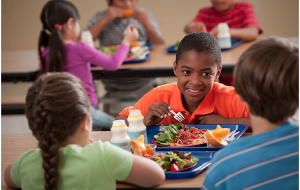The food we eat helps supply our brains with the energy they need to function well. During the school year, children spend roughly 35 hours per week in school where they are focusing, learning, communicating, and thinking. All of these tasks require children’s minds to be alert, and a balanced diet to supply them with quality energy helps them do so. From breakfast, lunch, and dinner to the snacks in between, you can discuss with your kids how to fuel their bodies with healthy food at home and at school.
Here are some tips to get them off to a good start this school year:
- Your kids can get their day off to an energizing start by eating breakfast. Whether they eat at home or at school, encourage them to choose whole-grains (such as oats and whole-wheat bread) and fruit for fiber, and nonfat/low-fat dairy for protein. These nutrients can help keep them full until their snack or lunchtime. Check out this link to find ideas for breakfast foods your kids will love: http://www.clemson.edu/extension/hgic/food/nutrition/nutrition/life_stages/hgic4106.html
- School lunches have made big steps towards providing children with healthier options since I was in school. Look at the cafeteria menu and talk to your kids about
 the healthier options on the menu. On those days that there are not as many choices of fruits, vegetables, and other foods low in fat, sodium, and sugar, help your children decide what they would like to bring from home for lunch.
the healthier options on the menu. On those days that there are not as many choices of fruits, vegetables, and other foods low in fat, sodium, and sugar, help your children decide what they would like to bring from home for lunch. - Consider this: a lunch packed from home isn’t automatically healthy, because it could still include the same types of food in the cafeteria you’re trying to avoid, such as pizza, French fries, and sugary beverages. How can you ensure that the food you pack your kids is going to fuel them well? Aim for whole, minimally processed foods, including whole grains, fruits, vegetables, lean protein, and nonfat/low-fat dairy. Also, choose water to drink to keep them hydrated and focused!
- Do your children have snack breaks at school? Vending machines are still readily available for children in many schools. Talk to your kids about why vending machines foods aren’t the best choices, and brainstorm ideas of healthier alternatives that they can bring from home, such as whole grain crackers and low-fat cheese.
- Cold foods should be kept cold to avoid getting sick from eating the food. If a refrigerator is not available, choose a lunch box with insulation, and pack it with ice packs that will keep it at a safe temperature until they’re ready to enjoy the food.
- Sweets and salty snacks don’t have to be avoided altogether. I love a bowl of ice cream after a long day or a bag of chips with my lunch once in awhile. Explain to your kids that a healthy diet can include these foods, just in small servings. A healthy diet is a balanced diet!
- Including your children in these decisions is very important. If they don’t like the foods you send them to school with, who’s to say they’ll actually eat it? Set a good example for them at home and expose them to many different healthy foods to encourage them to eat well.
Eating a healthy diet won’t guarantee good grades and behavior in school, but it can promote them!
Wishing you all a nutritious and balanced start to the school year,
Cara
Cara is an EFNEP student intern.